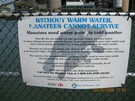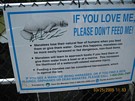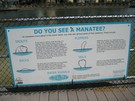


Last Update: 25-AUG-2018
We wanted something different this year and could not find a cruise that we wanted to go on. Mary and I wanted to check out the SW coast of Florida and with the so called recession we found that rental house prices were very low.
Always amazed at how easy it is to drive to Florida from here. Its a easy first day (we made it to Ocala, Florida appx. 890 miles) and then it was not far to Naples for the second day. Coming back we did make a mistake of traveling on the weekend. We hit heavy traffic up I-75 from Naples all the way past Tampa. Then major problems in Georgia near Brunswick. It was a combination of construction and spring break traffic.
Coming back we made it to Fayetteville, North Carolina. We would have made it further but with all the traffic it slowed us down.
We like Florida again because its close, friendly and being a pro gun state I can travel heavily armed !
I can easily see us doing this type of trip every year.
Two cameras were used on this trip. If the file name is (IMG_number) it was a Cannon Powershot SD750 Digital Elph. For its size it takes very good photos. If the file name is (DSCNnumber) it was taken with Dave's Nikon D-70 (Much better optics)
Miles driven were appx. 2,600 Vehicle used was a 1998 Dodge Durango. We had no issues.
Easy second day from Ocala (Stayed at a Micro Tel which was great but hard to find) Only had 250 miles to go and a number of stops to break up the day.
Manatee Viewing Center
Manatee Viewing Center located next to TECO Energy - Big Bend Power Station. Located in Apollo Beach along the clean, warm water discharge canal of Tampa Electric's Big Bend Power Station, the Manatee Viewing Center welcomes the public annually from November 1 through April 15. Come experience a tidal walkway showcasing vibrant Florida plants and birds, butterfly gardens, our educational building, and - when the water temperature of Tampa Bay falls below 68 degrees Fahrenheit - manatees. Admission and parking are free!
Information
Tempature of the outflow area, Close to 81
Various Views. We saw a number of manatees but only with the video camera
Naples area
Doubletree Hotel Guest Suite Naples 12200 North Tamiami Trail Naples, FL United States, 34110 Tel: 239-593-8733
Nice hotel but too far to walk to beach. Pool was nice and top floor would have provided view of canal, but we were on first floor because we got gov't rate of $120/night.
Our first trip to the beach was to Clam Pass Park. Its accessable via A boardwalk leading through a Mangrove forest to the beach at Clam Pass Park. People can walk to the beach or ride chaffeured 8-seater golf carts. We walked the 1/2 mile to the beach and rode the golf cart back. Nice clean beach.
Looking North at Clams Pass
Looking South at Clams Pass
Sunset from Clam Pass Park
Funny ! At Doubletree Guest Suites Naples, they had space reserved at the hotel for Hybrid Vehicles.
Corkscrew Swamp Sanctuary
Our plans for the day was a trip to the Corkscrew Swamp Sanctuary located East of the Naples area.
Corkscrew Swamp Sanctuary is a National Audubon Society sanctuary. The sanctuary was established to protect one of the largest remaining stands of Bald Cypress (Taxodium distichum) and Pond Cypress (T. ascendens) in North America from extensive logging of the tree that was ongoing throughout the 1940's and 50's.
We walked the boardwalk a bit over (2 miles) in length provides walking access through (actually 'over') pine flatwoods, wet prairie, Pond cypress, Bald cypress, and marsh ecosystems within the sanctuary.
The sanctuary is an important breeding area for the endangered Wood Stork, and other wetland birds, and has good numbers of wintering passerines, including the Painted Bunting. Numerous wading bird species can be found in the wetlands of the sanctuary, including the Yellow-crowned Night Heron, Black-crowned Night Heron, Tricolored Heron, Great Egret, and Snowy Egret. Specialist birds include Limpkin, Barred Owl and, in summer, Swallow-tailed Kite. As such, it has been designated as a 'gateway site' for the Great Florida Birding Trail.
American Alligators and Cottonmouths, an indigenous venomous snake, are also fairly prevalent here.
Raccoons under the bird feeders
The plant with a red flower is a Cardinal Wild-Pine. Also called Cardinal air plant, this is a bromeliad. It is an epiphyte, which means it attaches itself to another plant. Epiphytes are sometimes called air plants because they do not need to root into soil to survive.
Again, another very dry year. Worse than it was 2 years ago.
Blue Flag Iris (Iris Hexagona)
These spiders were everywhere. They had an hourglass. But, I don't think they were black widows
Nice boardwalk
Strangler Fig. Amazing as it grows down from the top of the tree.
We were getting worried. We went in the clock-wise direction and it was so dry. But, we hit the first big wet area.
Wood stork. We saw a rookery and were told this was an excellent year for survival of the young.
Immature white ibis, roseate spoonbill and snowy egret
Immature white ibis
Delnor-Wiggins Pass State Park
Back to the Beach. Delnor-Wiggins Pass State Park. Not many people out.
Sunset time
The second full day in Naples we spent most of the day at the hotel as it was so windy. But, we came out onto the beach in the evening for the sunset.
Unknown seed pod along the dunes at Delnor-Wiggins Pass State Park (may be Cassia ??)
Downtown Naples / Naples Pier
On the way to Marco we made a quick stop at the Naples Pier.
Built in 1888 as a freight and passenger dock, The Naples Pier stands as a community landmark. Narrow gauge train rails spanning the length of the pier transported freight and baggage in the early 1900's. Part of the structure as well as the post office located on the pier was razed by fire in 1922. Rebuilt after damage by hurricanes in 1910, 1926 and 1960.
Looking South
Dangerous place. Too many people fishing and not looking around to make sure it was clear to cast.
Looking North
Views of the beach from the Naples Pier
Only 30 miles to drive from Naples to Marco.
Briggs Nature Center
Went for a walk on the boardwalk at Briggs Nature Center, run by the Conservancy of Southwest Florida.
Welcome to Marco Island
Views of Marco Island from the bridge on FL 951
The house: On Kendall Drive, Marco Island, Florida in March / April "This south facing, waterfront 3 bedroom home is just a 5 minute walk from Tigertail beach. The home features a heated pool as well as a dock. Short walk to shopping and dining. Great views of the Marco skyline!"
We picked this one because of closeness to Tigertail Beach (10 minute walk). It had 3 bedrooms and its own pool and lanai. It was definitly a rental as Ken had to fix pool heater and a number of other things, but for $100/night per couple, it was a good deal. Quiet at this end of island and we will return! Impressed with Tigertail Beach.
Tigertail Beach, shells and critters
The birds had no fear !
Learned later that he is used to fishermen feeding him and maybe thought our closed umbrella was a fishing pole...
Mary finds stick bugs doing the wild thing on the beach !
Mary & Monika out to watch another sunset.
Many of the shells are still alive
Night shots with no tripod. But, you get the idea.
A Brown Widow spider on the wall back at the house (ID thanks to Bugman)
The green iguana or common iguana (Iguana iguana) is a large, arboreal herbivorous species of lizard of the genus Iguana native to Central and South America. The green iguana ranges over a large geographic area, from southern Brazil and Paraguay to as far north as Mexico and the Caribbean Islands; and in the United States as feral populations in South Florida (including the Florida Keys)
It liked to hang out on our boat lift behind the house.
Green heron, on the same boat lift, that we saw going in and out of a palm across the canal.
Rental house street views. VERY QUIET !
Back out to the beach as its sunset time. Our best at Marco Island.
Urchin
Another crowded day on the beach
Heading back to the beach for sunset. Along a short boardwalk over the dunes at Tigertail Beach
The widest beach I have ever seen
Very cool... Frigatebirds. This definitely at the northern range of these tropical birds. We saw them every day !
Sunset time. Another good one !
Another busy day at the beach !
Amazing suit. This woman was falling out of it !
Another beautiful day / sunset, No green flash. The Ferry coming back from Key West traveling under the setting sun
The pool heater / pump and mess. I had to fix this almost every day ! Intersting use of a heat pump. Before I messed with it the pool was in the mid 90's ! Would love to see that electric bill !
Views of the house from a vacant lot down the street
Upper end of Tigertail Beach where the waves were washing over.
Amazing amount of shells. Not a good beach to swim barefoot.
We did walk as far north as you could on the beach. It was a over wash area and was close for wildlife at the end.
Birds, And shells of the area
We all got tired of the beach days and our skin needed a break. Mary and I did this ride a few years back and we wanted to see how things changed over the last few years.
Our first stop was the Big Cypress Bend Boardwalk
Easily accessible from Highway 41, the boardwalk offers a awesome short stroll out into the Fakahatchee Strand State Preserve where you'll discover more tropical plant species and wildlife in one area than you would think was possible. This is one of the finest nature walks you can experience!
Walk underneath a canopy of native Royal Palm and Cypress trees and make your way down the boardwalk further into the Fakahatchee Strand. Look to either side where beautiful bromielads and orchids cling to the trees which give this area an Amazon-like feel. White Herons contrast with the dark surroundings and huge ferns, making for a great photo opportunity.
Along the boardwalk a large Bald Eagles Nest was visible. The web said that its been active since 1991.
After we left Big Cypress Bend Boardwalk, We took some back roads. Up FL-29 to CR-837. Took this over to CR-840A which runs North South. One of these days I want to ride this road north till it ends a few miles north of Alligator Alley. But, not on this trip. What is interesting about CR-840A is that it follows the Turner River Canal so, its loaded with critters ! And these gators that you find along this road are not the tourist types... They react to you and move fast when you apprach where they are resting.
Lots of dust !
Well, we went south back to US-41 and stoped at H. P. Williams Roadside Park We stop here every time we are down this way. Always something to see. Located within Big Cypress National Preserve, this is a nice place for a picnic. There's a boardwalk, plenty of parking, information, and maps.
We think these are Red Turtles
Our next backroad adventure is along CR-94. It's appx. 11 miles east of H. P. Williams Roadside Park. This road is a bit more remote. A few mils south of US-41 say goodby to Cell Service !
After a few miles you come to a very wet area that usually has a good bit of wildlife. This year it was very dry but we still say a number of critters !
Barred Owl right along the road.
Great Blue Heron
Great Egret
White Ibis
A few more miles we came to another opening with lots of wildlife
CR-94, Dirt and straight !
The Wood Stork (Mycteria americana) is a large American wading bird in the stork family, Ciconiidae. It was formerly called the "Wood Ibis", though it is not really an ibis.
This is a subtropical and tropical species which breeds in much of South America, Central America and the Caribbean. The Wood Stork is the only stork that presently breeds in North America. In the United States there is a small and endangered breeding population in Florida, Georgia, and South Carolina, along with a recently discovered rookery in southeastern North Carolina
The Roseate Spoonbill (Platalea ajaja, sometimes separated in the monotypic genus Ajaia) is a wading bird of the ibis and spoonbill family, Threskiornithidae. It is a resident breeder in South America, the Caribbean, Mexico, Central America, and the Gulf Coast of the United States.
The Anhinga (Anhinga anhinga), sometimes called Snakebird.
The Anhinga (Anhinga anhinga), and a Litle Blue Heron juvenile
Great egret and a Little Blue heron
White Ibis. (The brown ones are immature)
Everyone enjoying the +90 degree temps !
Roseate spoonbill
Anhinga
Tricolored heron
CR-94 takes you back to US-41 at Fortymile Bend. Yup, 40 miles from Miami !! Close enough for us. So, we start heading west on 41 and a quick stop to see the huge gators in the pond in front of the Osis Visitor Center. Its only 48 miles back to Marco Island.
Not even April and its looking like Summer !